
Namibia chapter fifteen
Sandwich Harbor: Where the desert meets the sea.
John Robbie greets us at the tourism office in Walvis Bay and introduces himself as our guide for our morning’s excursion to Sandwich Harbor. I’m with two friends from Windhoek, who are here for a long weekend. He leads us to his Landcruiser and has us hop inside.
We drive south towards the edge of town. He points out an area neaer the outskirts where flamingos gather. He tells us we can stop on the way back or visit on our own; he’s eager to get going and so are we. Later, I realize that part of the reason he might be in a hurry is because of the tides. The harbor is only accessible when the tide is low; otherwise you’re relegated to driving along the dunes, forced to view the landscape from above.
Just outside of town we pass a large sea salt mining operation. Large pools lay under the clouds, the water slowly evaporating to leave salt deposits behind. Robbie tells us that 30,000 tons of salt are mined here every month. It’s the largest salt mining facility in the southern hemisphere.

Leaving the salt mine behind we head back into the desert. Vegetation slowly gives way to reveal the sand, small dunes forming around clumps of bushes. Robbie tells us that the dunes are created by bushes that take root, catching the sand around them as the winds blow from the sea.
He tells us we can use the dunes to help find our way in the desert, that vegetation will only grown on the south side of the dunes. He also asks us if we’ve noticed lines in the dunes. We have. He tells us the lines run east/west, and that the black edges of the lines also point south. Finally, he tells us that the red dunes are older than the yellow ones as they’ve had more time to let the iron oxidize, so that here, you want to walk in the direction of the yellow dunes to find your way to the sea.


We pass a red lagoon and Robbie tells us it’s the plankton that gives it its color. He tells us that in Namibia most of the rivers run underground. He tells us only two run always above the surface, The Orange in the south, which carries the sand and diamonds from South Africa to the Atlantic, and the Cunene River in the north on which Epupa Falls sits.
He tells us springbok live in the area, adapted to eat the local bush. The salt makes them unappetizing to other animals and so they are very chill. He jokes that springbok come here to retire.

The dunes become larger as we drive south and we wind our way through the sand. At one point, Robbie turns to make make a point and we feel the Landcruiser list to its side, our forward momentum stopped. We’ve slid down the side of the track. Robbie guns the engine and sand rains into the vehicle, covering me from head to toe. Roll up your window! Robbie calls out to me. Duh.
He steps on the gas; the tires throw large plumes of sand into the air. He puts the window wipers on to brush it away. We’re stuck. Everybody out, he says. I climb out of the driver’s side; the pitch of the car makes it easier that way.
Help arrives in the form of other groups and Landcruisers. Robbie’s been on the radio and needled by his fellow guides. One pulls out in front of our car and uncoils a rope, attaching it to the chassis of our Landrover. Robbie guns it, but it’s not enough. They crawl under the car to dig it out before trying again. This time they succeed.



We drive on towards the harbor. We’re on the western edge of the Namib-Naukluft National Park. The Sossusvlei entrance marks the eastern edge. I’ve flown over this the desert and seen where the sand meets the sea, but driving along the coast and watching the waves wah in offers a completely different experience.




Another vehicle seems to race us inland. Robbie tells us that only licensed guides and vehicles are now allowed into the area. There were too many amateurs getting stuck in the sand and the tides, abandoning their vehicles to the sea.
We spot a jackal on the beach and stop to let it pass before continuing. A sign warns us that the area is inadmissible at high tide.


We race along the edge of the ocean. Robbie is careful to leap ahead only when the waves are going out, careful not to drive across the receding surf. It’s utterly beautiful. The dunes rise calm and majestic to one side, the sea agitates on the other.
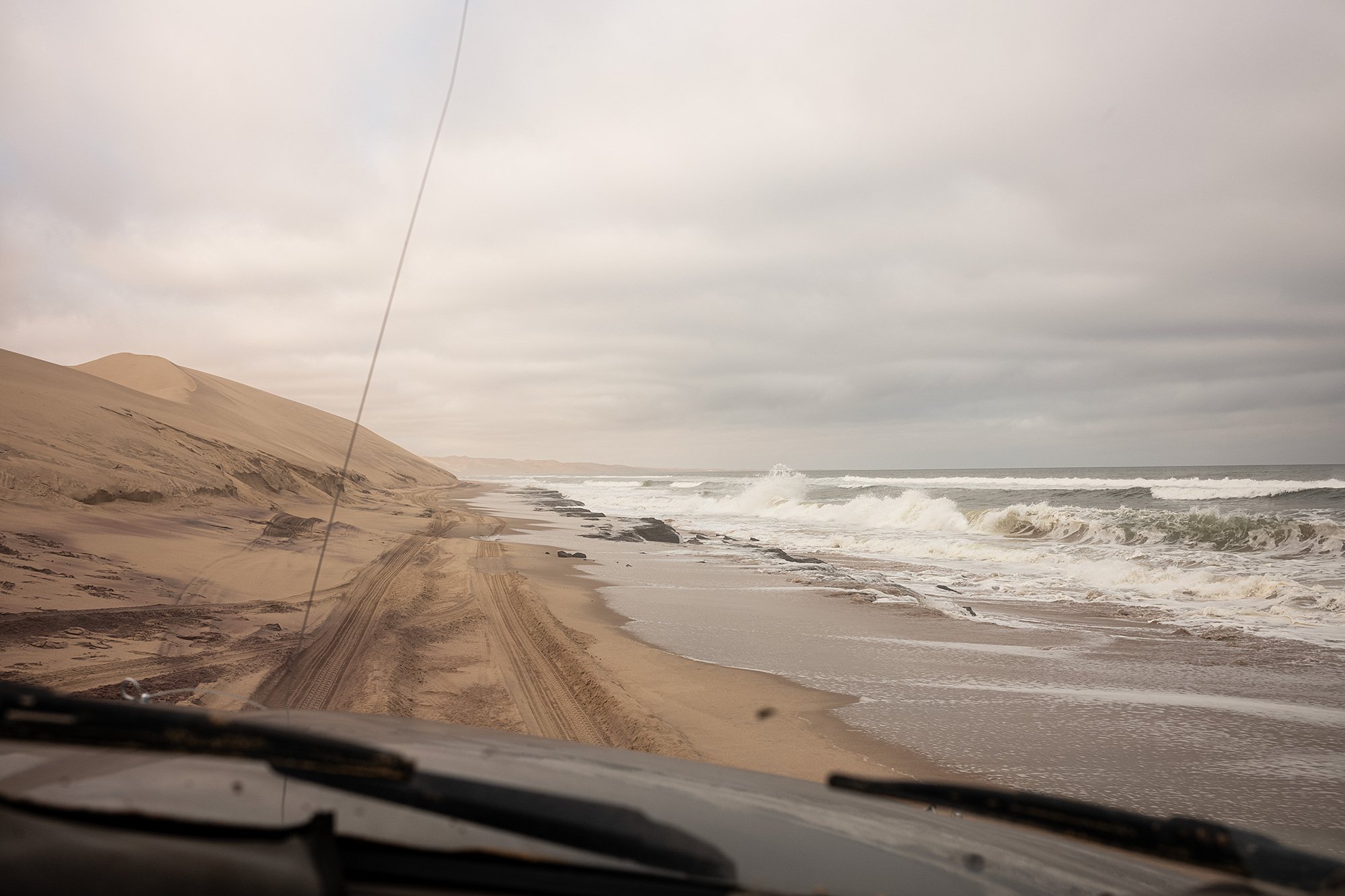

Robbie stops near where the water seems to crest closer to the dunes. He asks us if we want to climb the dunes. We alight and I begin climbing straight up the slope next to us to a small saddle. It’s not a particularly difficult climb, but I’m surprised at how much altitude I gain in a relatively short amount of time.



Looking to my right I spot a peak that doesn’t look too difficult or far and decide to hike up a little further for the view, hoping for a sweeping look to the south. I’m still unaccustomed to hiking along the ridge of dunes and I struggle with the ascent.
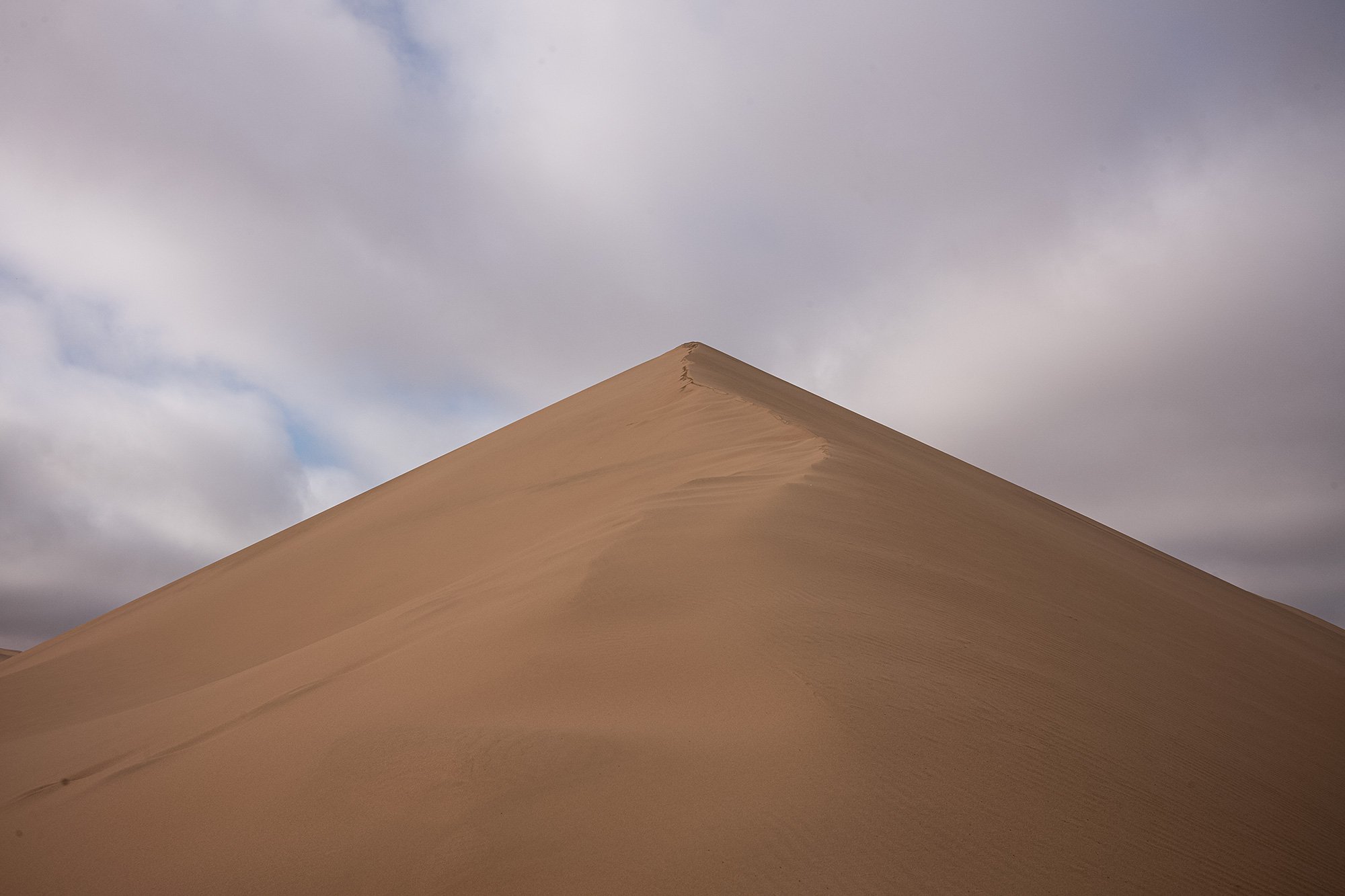




When I reach what I thought was the peak I see more peaks ahead of me. I don’t want to take too much time but it doesn’t look like much and so I press on. Behind me, I see the couple have reached the saddle and are taking photos of each other and the sea.



Much to my chagrin, there appears to be no end of peaks. As I reach what I assume to be the summit another appears. Looking south there are an unbroken series of summits.
The light shifts constantly; the landscape shifts with it. I could spend an eternity watching the waves move across the sea, the sunlight wave across the sand

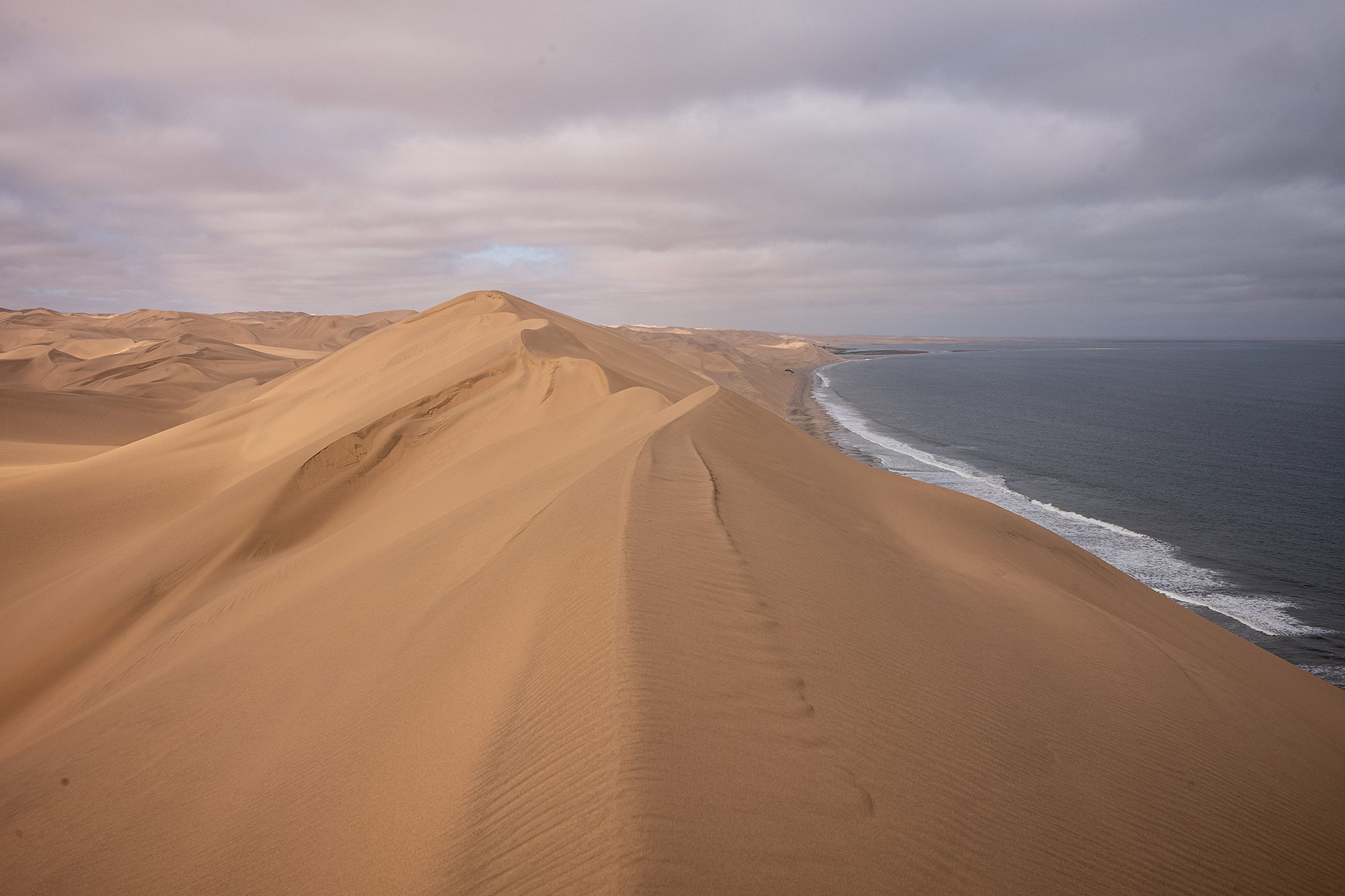



Every moment the light shifts, the colors change. I want to stand right here forever, but looking down at the waves, I can see the tide coming in. Turning around I see another vehicle parked on a faraway dune, its passengers stand in a line on the ridge, gazing out towards the sea. I turn back and start to head down. I see one of my fellow passengers, a dot in the saddle. She’s come to find me. Once she sees me approach I see her turn and start down the slope.


Reaching the saddle I look down and see Robbie and my fellow passengers standing by the car. I make quick progress towards them. Robbie tells me that had I been any longer we’d have had to have slept there. He tells us the beach owes its name to the fact that at high tide the beach is sandwiched between water. He tells us that that happens in only two places; the other beach is in Angola.
We pile into the car and he quickly turns us around, dodging the waves as we race north towards an opening in the dunes the car can climb.


Robbie drives us up and through the dunes to the standard viewpoint common to all tours. A few other vehicles are there before us, a collection of tourists stand on the edge and gaze into the distance, take photographs of the landscape and each other. A steady wind blows from the ocean and we cinch up our coats against the cold.
Robbie warns me not to run off. I smile back at him.


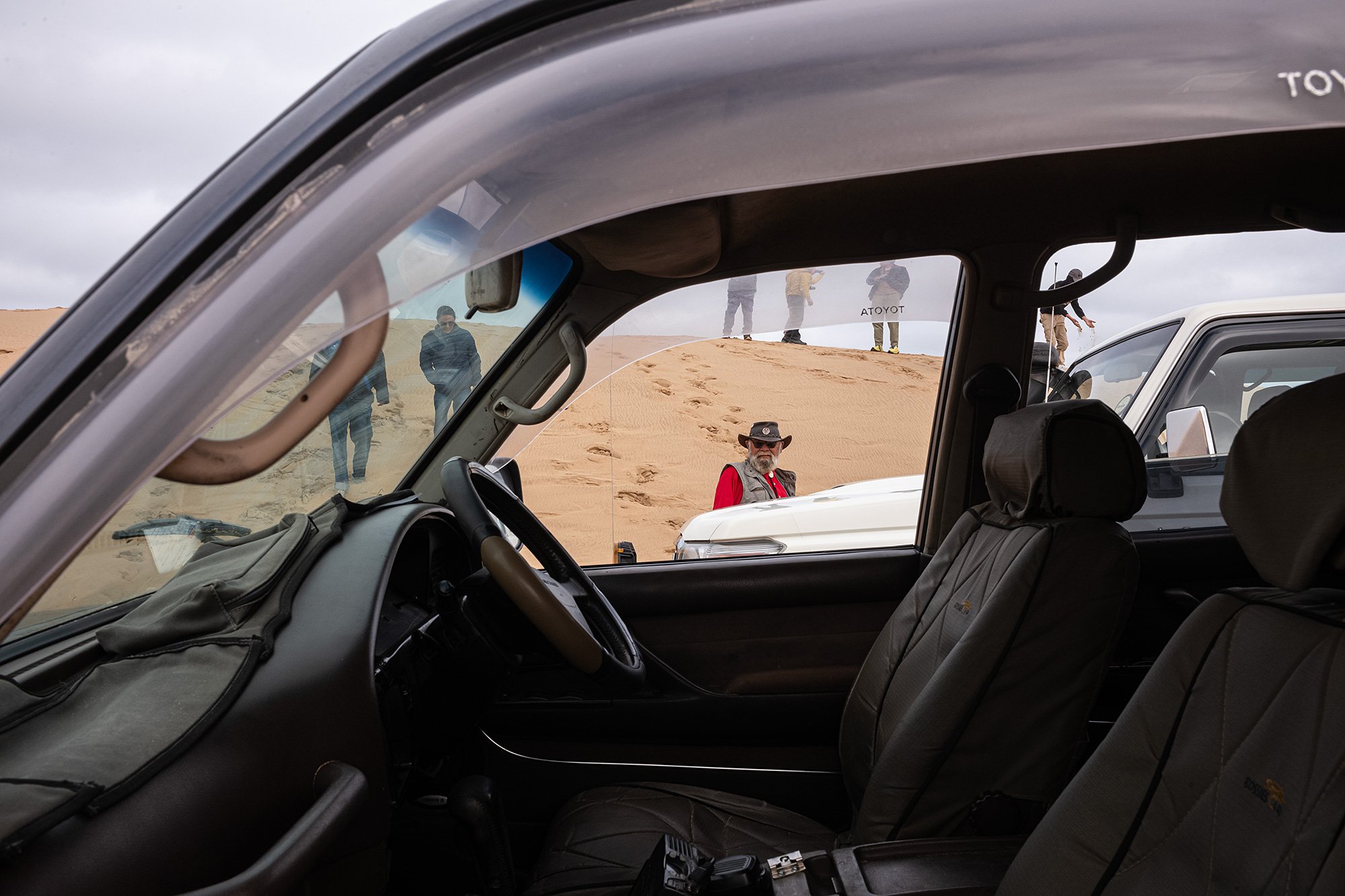
Back in the car Robbie takes us on a tour of the dunes, driving up and over and down. It’s like a rollercoaster ride in slow motion as he takes his time on the steeper slopes. It’s thrilling to have our run of the place. There’s seemingly grade Robbie won’t brave.




In a bowl surrounded by dunes Robbie stops the car and climbs out. He produces a folding table and lays a tablecloth over it. He unwraps a large platter of snacks and a smaller platter of Walvis Bay oysters and opens a bottle of champagne. We toast each other and thank Robbie for the tour he’s given us.
Omuz and Robbie chat in a mixture of English and Afrikaans. She’s quick to laugh, making her an enjoyable companion. Her laughter and jokes have punctuated our trip. At one point she mentions something which prompts me to ask her if she works in tourism. Yes, she answers. You’ll probably recognize the logo.
She shows me the back of her phone. A sticker of a handprint is affixed to it, the logo of the Gondwana Collection, a hub for travel in Namibia with its own portfolio of hotels and lodges. I tell her that on the last day of my roadtrip I’ll be staying at the Etosha King one of their properties just outside the national park. She’s excited for me and wants me to tell her what I think.
She asks me where I’m off to next and I list out my itinerary for the next few months. She also wants to know what I think of the roads in Botswana. She’s proud of the roads in Namibia. She spent some time touring Botswana last year and became homesick for her roads.
She asks me where I stayed in Sossusvlei. When I tell her her eyes go wide. Robbie laughs and jokes that when Americans come to Namibia they (he mimes making it rain dollar bills). I laugh along with them.
Omuz and I polish off the oysters and sparkling wine. They’re delicious and I wish we could order more.

The sun burns off the cloud cover as we eat. We help Robbie put everything back in the car when we’re finished. On the drive back it feels like a completely different day. The skies are blue and mostly clear, the crashing surf and sand clear and bright.


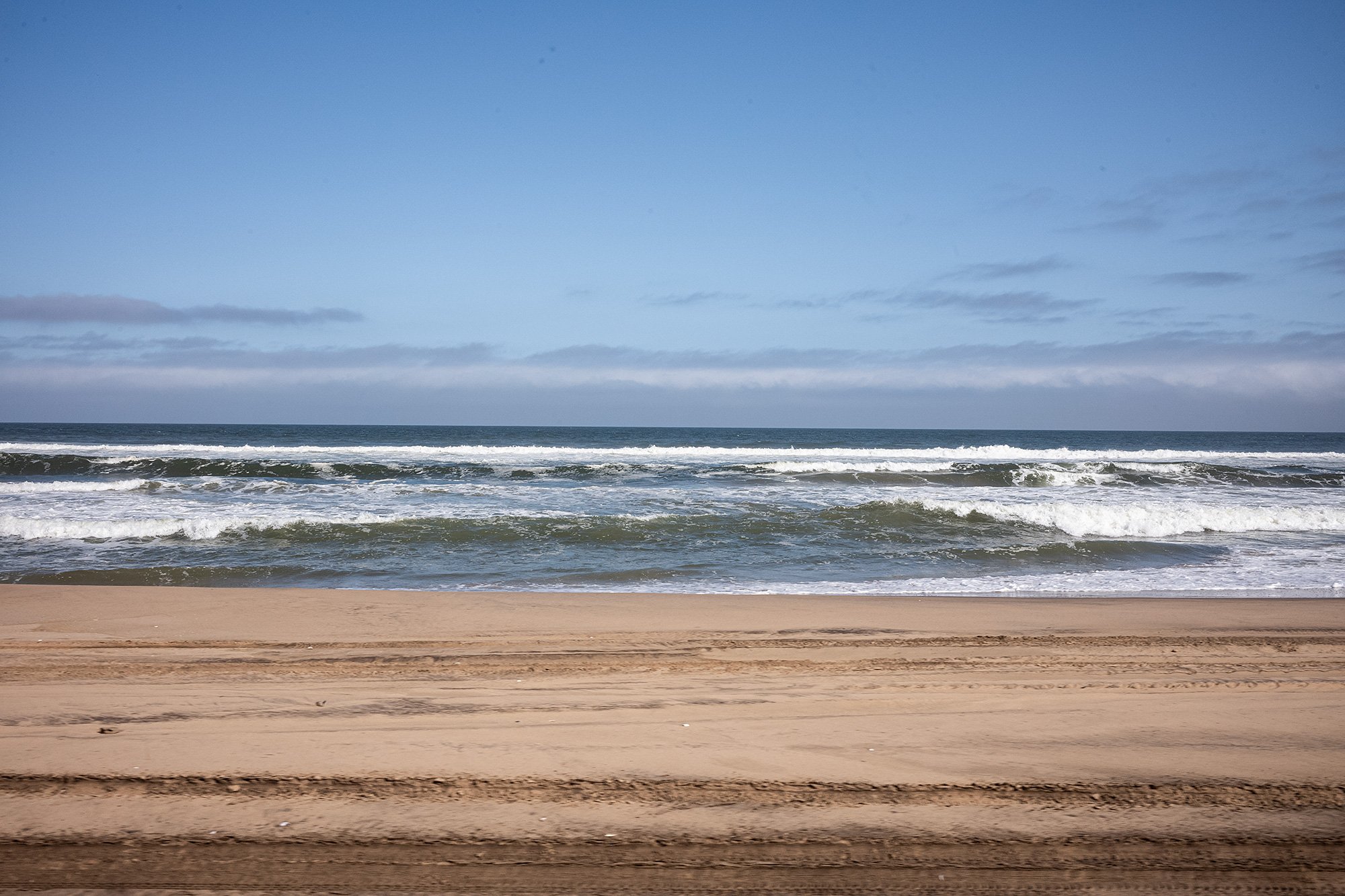
A flock of flamingos hangs by a small pool and we stop for a moment to have a look. Robbie tells us that they breed in Etosha, a three-day flight away. Young flamingos spend three years in the area before flying north to the breeding grounds. He tells us they fly by night; during the day they’re vulnerable to birds of prey.
I open the door slowly to get out to take a better photo, but they spook and fly away before I can approach.


Omuz asks me why I take photos. It’s a good question. I tell her it’s a way to help me remember my experiences, it’s another way I experience them. I tell her it’s also a way to share my experiences with others and promise to send her links to the photos when I post them.
Robbie chimes in. They’re also only for you. The sands are constantly shifting, the landscape constantly changes. What you’ve captured today is gone tomorrow.
I ask him how he got into guiding. He tells me he retired a number of years ago. He used to fish and work in the canning factories. After retiring he didn’t want to do nothing and so he got a license and started guiding. He shows no sign of slowing.
Passing the sea salt mine, the pools light up fuschia under the sun. The colors seem to bleed into the flamingos that snack along the shore.

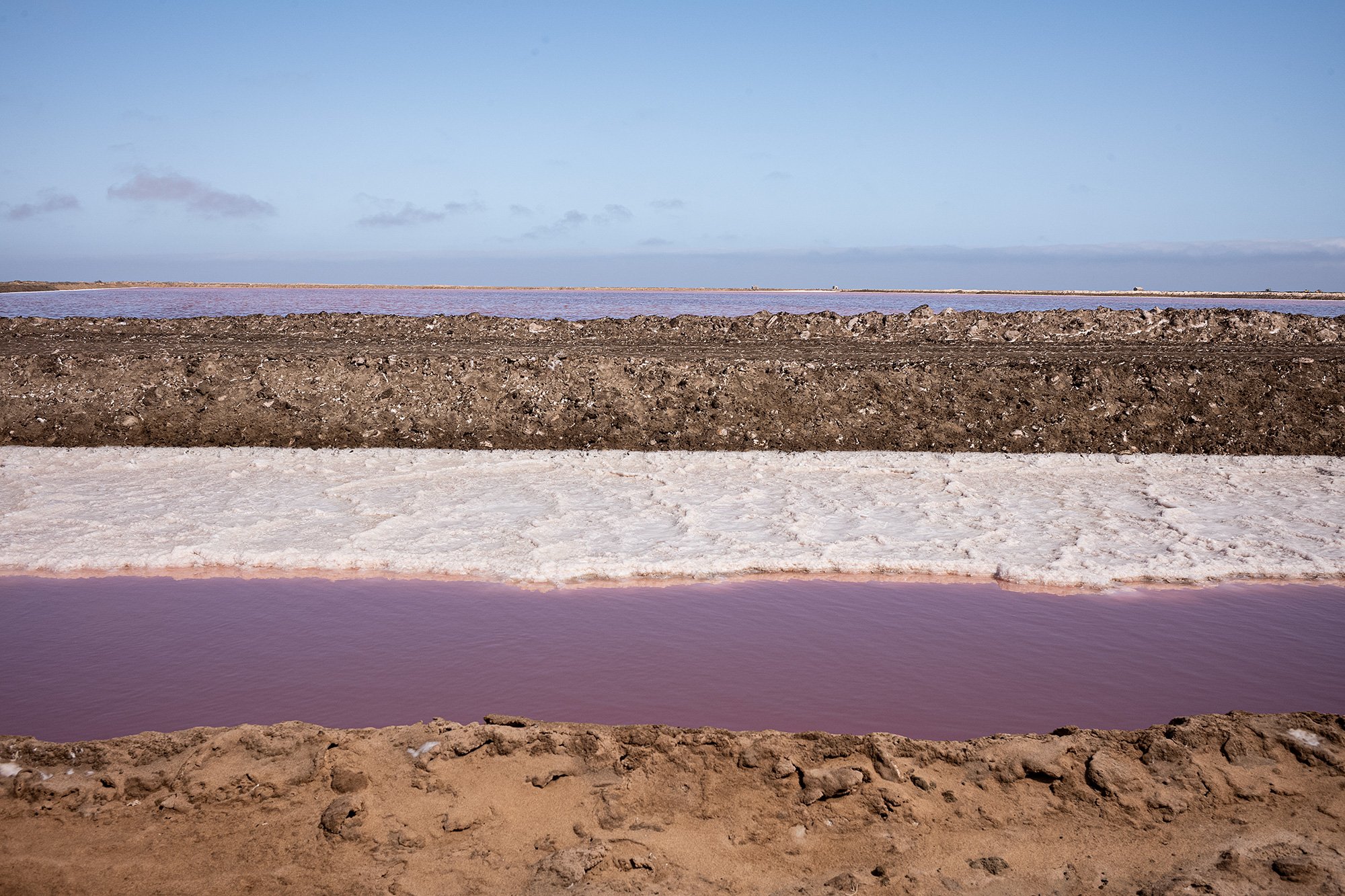

We part ways at the parking lot. Robbie has another set of guests to take to the harbor. It’s his third set of three for the day. Omuz and I exchange WhatsApp numbers. I tip Andreas, the parking attendant and ask him where he’s from. He’s from the north, near the panhandle. He’s far from home, his surroundings a completely different world from what he’d known.
On the drive back to Swakopmund I pass again the avenue of palms that line the road heading out of Walvis Bay. I watch the world pass through the windows, past the palms. Small figures dot the desert, walking to and fro. It’s hard to believe so much water exists just on the other side. 🇳🇦
31 May 2024



